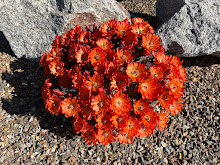It's not a plant that everyone would want to grow even though it has such amazing flowers. The problem is that when the flowers opens they emit a smell like rotting flesh. And you know what is attracted to rotting flesh-flies. Who wants to attract flies to their garden?
Surprisingly, Stapelia gigantea, is a member of the milkweed family, Asclepidaceaea, and native to South Africa. Sometimes called the carrion flower because of that smell of rotting flesh, the flowers even have the texture of animal skin, including long hairs.
Don't rub your finger across the surface because something you don't like is sure to rub off on you.
The flower parts are found deep in the center of the plant requiring a very small pollinator. When I looked at the flowers a day later there was evidence that a pollinator had been by or at least something had laid its eggs in the center of the flower. They had hatched overnight and were wiggling around. I wasn't waiting around to find out what they would turn into. Promptly dispatched into a sealed plastic bag.
I was surprised to see flower buds just 3 days ago and had been watching each day for the momentous occasion. You can see the twist at the end of the flower bud. I'm guessing that tension must build up in the twist until the flower just bursts open.
It's not the only stinky flower in my garden. Huernia schneideriana, is hanging in a planter on the gate, but its flowers are tiny and you have to get up very close to detect any aroma.
Both these plants have similar stems. This one may look spiny but it isn't. The stems are upright when young but then drape with their own weight. In nature they would like to spread along the ground sending out roots along the length of their stems. They make the perfect draper until their branches get heavy and just drop off. Unfortunately for them it is usually onto the concrete. Neither of these plants are hardy in Texas but they never bloom during the winter so there is no danger of that smell in the house.
Sunday, September 20, 2015
Subscribe to:
Post Comments (Atom)

































6 comments:
Such cool flowers though! I had never thought of the fact that the flies will actually lay their eggs in the flowers. When they are kept inside all the time as houseplants that is probably not as much of an issue.
Oh my! I think you may have just identified a new succulent for me. It wasn't labeled when I picked it up but I liked the plant's structure and it appeared to have tiny flower buds so I brought the unidentified plant home and potted it up. It remains to be seen if what I have is a Stapelia gigantea.
I wouldn't like the smell, but those are such very cool plants! I just love the planter with the hanging plant. Very striking and more unusual looking!
Astonishingly beautiful. I suppose those flowers smell delicious to their intended audience at least. So you over-winter these in the greenhouse (and good news they don't bloom off season)?
The Stapelia flowers look really cool spread out and supported by the terracotta jar - nice staging!
I would think the stink just adds to the charm. I have several Amorphophallus in the back garden, and they are similarly scented and pollinated by flies.I love their oddity.
Post a Comment